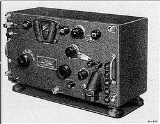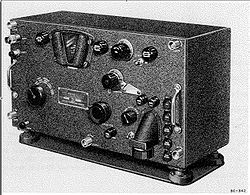
BC-342
Encyclopedia
The BC-342 was a World War II
U.S. Army Signal Corps radio receiver
with high frequency
band coverage. It was a 115 Volt
AC
version of the BC-312 receiver, used primarily as part of field installations. A number of units were manufactured by the Farnsworth Television and Radio Corporation
of Fort Wayne, Indiana
.

amplifier
s, a 6L7 mixer, a 6C5 local oscillator, two 6K7s as IF amplifiers, a 6C5 CW oscillator (BFO), a 6R7 detector/1st AF, a 6F6 audio output, and a 5W4 rectifier. The first audio stage contained the detector as well, integrated into one circuit.
In addition to the AC power supply, the BC-342 was wired for 12 volt
s for its tube filaments. The 9 tubes were wired so that three pairs of 6 volt tubes were wired in series. The audio
output tube was a 6F6 in series with a pair of tubes, a 6C5 and a 6R7, along with a balancing resistor
. The 12 volt DC versions of BC-312 used similar connections. Models of the BC-312 designed for 24 volts DC
used sets of four 6 volt tubes each in the series filament strings, with an 12A6 audio output tube in series with a resistor. All BC-312 used a dynamotor to supply B+ from the DC source.
The BC-342 was similar to a number of radio receivers used in military vehicles and aircraft
during World War II such as the BC-348
. There was a general requirement for ruggedness and stability, so a heavy, screened chassis and case was employed to minimize drift and oscillator instability due to temperature changes and vibration.
World War II
World War II, or the Second World War , was a global conflict lasting from 1939 to 1945, involving most of the world's nations—including all of the great powers—eventually forming two opposing military alliances: the Allies and the Axis...
U.S. Army Signal Corps radio receiver
Receiver (radio)
A radio receiver converts signals from a radio antenna to a usable form. It uses electronic filters to separate a wanted radio frequency signal from all other signals, the electronic amplifier increases the level suitable for further processing, and finally recovers the desired information through...
with high frequency
High frequency
High frequency radio frequencies are between 3 and 30 MHz. Also known as the decameter band or decameter wave as the wavelengths range from one to ten decameters . Frequencies immediately below HF are denoted Medium-frequency , and the next higher frequencies are known as Very high frequency...
band coverage. It was a 115 Volt
Volt
The volt is the SI derived unit for electric potential, electric potential difference, and electromotive force. The volt is named in honor of the Italian physicist Alessandro Volta , who invented the voltaic pile, possibly the first chemical battery.- Definition :A single volt is defined as the...
AC
Alternating current
In alternating current the movement of electric charge periodically reverses direction. In direct current , the flow of electric charge is only in one direction....
version of the BC-312 receiver, used primarily as part of field installations. A number of units were manufactured by the Farnsworth Television and Radio Corporation
Philo Farnsworth
Philo Taylor Farnsworth was an American inventor and television pioneer. Although he made many contributions that were crucial to the early development of all-electronic television, he is perhaps best known for inventing the first fully functional all-electronic image pickup device , the "image...
of Fort Wayne, Indiana
Fort Wayne, Indiana
Fort Wayne is a city in the US state of Indiana and the county seat of Allen County. The population was 253,691 at the 2010 Census making it the 74th largest city in the United States and the second largest in Indiana...
.

Specifications
The BC-342 was AC powered, allowing operation in fixed and mobile operation. It had a 470 kHz IF, crystal filter and used 10 vacuum tubes of the following types: two 6K7s as RFRadio frequency
Radio frequency is a rate of oscillation in the range of about 3 kHz to 300 GHz, which corresponds to the frequency of radio waves, and the alternating currents which carry radio signals...
amplifier
Amplifier
Generally, an amplifier or simply amp, is a device for increasing the power of a signal.In popular use, the term usually describes an electronic amplifier, in which the input "signal" is usually a voltage or a current. In audio applications, amplifiers drive the loudspeakers used in PA systems to...
s, a 6L7 mixer, a 6C5 local oscillator, two 6K7s as IF amplifiers, a 6C5 CW oscillator (BFO), a 6R7 detector/1st AF, a 6F6 audio output, and a 5W4 rectifier. The first audio stage contained the detector as well, integrated into one circuit.
In addition to the AC power supply, the BC-342 was wired for 12 volt
Volt
The volt is the SI derived unit for electric potential, electric potential difference, and electromotive force. The volt is named in honor of the Italian physicist Alessandro Volta , who invented the voltaic pile, possibly the first chemical battery.- Definition :A single volt is defined as the...
s for its tube filaments. The 9 tubes were wired so that three pairs of 6 volt tubes were wired in series. The audio
Audio frequency
An audio frequency or audible frequency is characterized as a periodic vibration whose frequency is audible to the average human...
output tube was a 6F6 in series with a pair of tubes, a 6C5 and a 6R7, along with a balancing resistor
Resistor
A linear resistor is a linear, passive two-terminal electrical component that implements electrical resistance as a circuit element.The current through a resistor is in direct proportion to the voltage across the resistor's terminals. Thus, the ratio of the voltage applied across a resistor's...
. The 12 volt DC versions of BC-312 used similar connections. Models of the BC-312 designed for 24 volts DC
Direct current
Direct current is the unidirectional flow of electric charge. Direct current is produced by such sources as batteries, thermocouples, solar cells, and commutator-type electric machines of the dynamo type. Direct current may flow in a conductor such as a wire, but can also flow through...
used sets of four 6 volt tubes each in the series filament strings, with an 12A6 audio output tube in series with a resistor. All BC-312 used a dynamotor to supply B+ from the DC source.
- Manual Reference: TM 11-850
- Components: RA-20 Power Supply
- Weight: 58 lbs.
- Frequency Range: 1.5-18 MHz
- Power Input: 110 VAC 60 Hz
- Part of: SCR-197SCR-197The SCR-197 was a ground mobile high frequency radio station used by the United States military prior to and during World War II, notably during the Battle of Wake Island in 1941.-Specifications:...
, SCR-277SCR-277The SCR-277 was a mobile, trailer mounted radio range set for radio guidance of aircraft. It was standardized by the U.S. Army in June of 1941.-Specifications:...
, SCR-299SCR-299The SCR-299 was a U.S. Signal Corps mobile military communications unit used during World War II.-History:The SCR-299 replaced SCR-197 and SCR-597, and was an effort to give a long-range communication advantage to the U.S. Army and its allies...
, SCR-399, MRC-1
The BC-342 was similar to a number of radio receivers used in military vehicles and aircraft
Aircraft
An aircraft is a vehicle that is able to fly by gaining support from the air, or, in general, the atmosphere of a planet. An aircraft counters the force of gravity by using either static lift or by using the dynamic lift of an airfoil, or in a few cases the downward thrust from jet engines.Although...
during World War II such as the BC-348
BC-348
The BC-348 is a compact American-made communications receiver, which was mass-produced during World War II for the U.S. Army Air Force. Under the Joint Army-Navy nomenclature system, the receiver system became known as the AN/ARR-11. -History:...
. There was a general requirement for ruggedness and stability, so a heavy, screened chassis and case was employed to minimize drift and oscillator instability due to temperature changes and vibration.
See also
- ARC-5ARC-5The AN/ARC-5 Command Radio Set is a series of radio receivers, transmitters, and accessories used to provide two-way Morse code and AM radiotelephone communication for U.S. Navy aircraft during World War II and the years following. It was an improvement of the Navy's ARA/ATA command set. Similar...
- Hammarlund super proHammarlund Super ProThe Hammarlund Super Pro was an American made radio communications receiver.- History :In March 1936, the Hammarlund Manufacturing Company initiated the first of the famous “Super-Pro” line, the SP-10 receiver, followed in January 1937 by the SP-100...
- National HRONational HROThe original National HRO was a 9-tube shortwave general coverage communications receiver manufactured by the National Radio Company of Malden, Massachusetts, USA.-History:...
- R-390AR-390AThe R-390A /URR is a general coverage HF radio communications receiver designed by Collins Radio Company for the US military.-History:The R-390A military shortwave radio receiver was the result of a project undertaken by the U. S. Army Signal Corps in 1954 to replace the existing R-390 receiver...
- Signal Corps RadioSignal Corps RadioSignal Corps Radios were U.S. Army military communications components that comprised "sets". Under the Army Nomenclature System, SCR initially designated "Set, Complete Radio," and later "Signal Corps Radio," though interpretations have varied over time....

